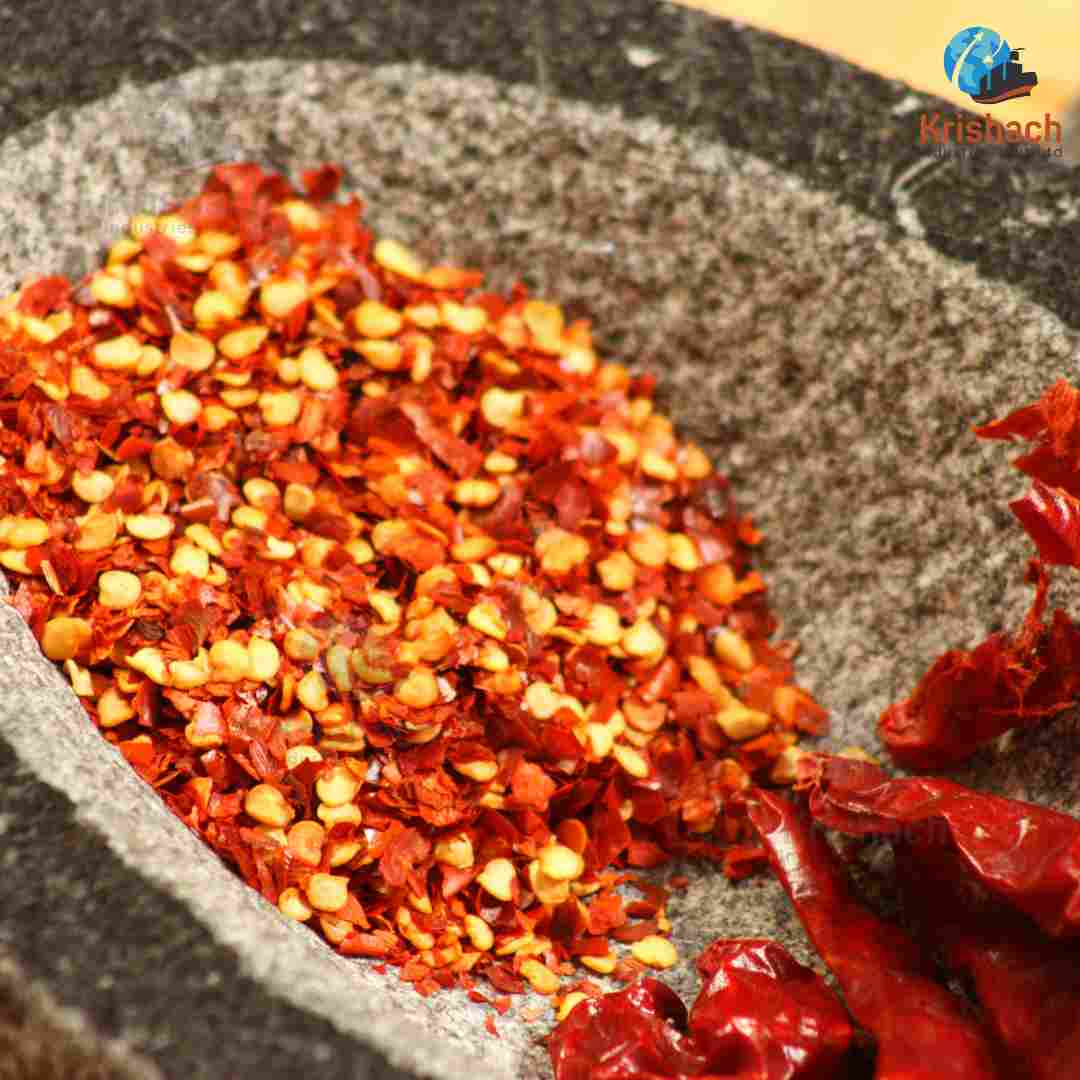Red chili flakes, also known as crushed red pepper flakes, are a popular spice made from dried red chili peppers. They add heat and flavor to a wide range of dishes. Here’s a detailed description:
Key Characteristics of Red Chili Flakes:
Form: Coarse, irregularly sized flakes that are the result of crushing dried red chili peppers. They often contain a mix of seeds, skin, and small bits of the pepper.
Size: Flakes can vary in size but are generally around 1-3 mm in diameter. The texture is uneven, with some larger pieces and finer powder mixed in.
Color: Bright to deep red, depending on the type of chili peppers used and the degree of processing. The color can range from a vivid red to a darker, reddish-brown.
Texture: Coarse and slightly crunchy, with a mix of flaky and granular elements. The texture can vary depending on the grinding process and the chili variety.
Aroma: Pungent and spicy with a strong, aromatic scent. The aroma is typically more intense when the flakes are toasted or heated.
Flavor: Spicy and hot, with a pungent kick that can vary in intensity depending on the chili pepper variety used. Red chili flakes can also have subtle fruity, smoky, or earthy undertones.
Key Differences from Other Forms of Chili:
Texture: Unlike chili powder, which is finely ground, red chili flakes are coarser and more textured. They offer a more intense crunch and visual appeal in dishes.
Heat Distribution: Red chili flakes provide bursts of heat and flavor, while chili powder mixes more uniformly into dishes, giving a consistent level of spiciness.
Specification:
Uses:
Culinary Applications: Red chili flakes are used to add heat and flavor to a variety of dishes, including pizzas, pasta, soups, stews, and stir-fries. They are often sprinkled on top of dishes or incorporated into sauces and marinades.
Seasoning: They are a popular ingredient in spice blends and seasoning mixes, providing a quick and easy way to add spice to recipes.
Health Benefits:
Capsaicin: Red chili flakes contain capsaicin, the compound responsible for their heat, which is known for its metabolism-boosting and anti-inflammatory properties.
Nutritional Value: They are a source of vitamins A and C, antioxidants, and other beneficial compounds.
Cultivate Seasons for India:
Red chilly is typically cultivated during the kharif season in India, with sowing done in June-July and harvesting in October-November.
Our Services
Reliable Sourcing :
To ensure a consistent supply of high-quality red chilies, establish strong partnerships with local farmers in major chili-producing regions like Andhra Pradesh, Karnataka, Maharashtra, and Tamil Nadu. Focus on sourcing from renowned areas such as Guntur, Byadgi, and Kashmiri, known for their superior chili varieties. Collaborate with farmers who practice sustainable and traditional farming methods to guarantee the chilies are non-GMO and grown without synthetic chemicals.
Premium Quality Assurance:
Implement rigorous quality control measures to ensure that red chilies meet international standards for color, heat, and purity. Secure certifications like ISO, HACCP, FSSAI, and USDA Organic to confirm adherence to global quality and organic standards. Regularly test for contaminants and moisture content, and use moisture-resistant, food-safe packaging to maintain freshness. Ensure full traceability of each batch from farm to final product to uphold quality and transparency.
Prossecing
To make red chili flakes, start by selecting fresh red chilies, washing them thoroughly, and removing the stems (and seeds, if you prefer less heat). Dry the chilies by either baking them at the lowest oven setting (140-175°F or 60-80°C) for 4-6 hours, using a dehydrator at 125-135°F (50-60°C) for 8-12 hours, or sun-drying them for 3-5 days until completely brittle. Once dried, grind the chilies into flakes using a spice grinder or a mortar and pestle, and store them in an airtight container away from light and moisture for up to 6 months.
Packaging, Shipping & Delivery
Packaging:
Bags and Pouches:
For Red Chilly Flakes, high-quality food-grade materials such as laminated multi-layer pouches (made of materials like PET, PE, BOPP, and Aluminum foil) are used. These bags are moisture-proof and help retain the freshness, flavor, and aroma of the spices. Zip-lock pouches, stand-up pouches, and resealable bags are also popular for smaller quantities.
Polypropylene (PP) Woven Bags:
These are the most common types of bags used for packaging large quantities (25 kg and 40 kg) of Red Chilly Flakes.They are made of woven polypropylene material, which is strong, lightweight, and durable, providing excellent resistance to tearing and damage during handling and transport.
Laminated Bags:
For additional protection against moisture and humidity, PP woven bags can be laminated with a layer of plastic film. This lamination creates a barrier against moisture, ensuring the spices stay dry and fresh during transportation and storage.
Multi-Wall Paper Bags:
These bags consist of several layers of kraft paper, which provide strength and are often lined with a plastic or polyethylene layer to offer protection against moisture and humidity. They are environmentally friendly and widely used in many markets for exporting food products.
Vacuum-Sealed Packaging:
This type of packaging removes air from the package before sealing, which helps prevent oxidation and moisture build-up, preserving the quality and extending the shelf life of the spices.
Paper or Carton Boxes:
After the packaging, the smaller bags or pouches are placed in corrugated cardboard cartons or paper boxes. These cartons are sturdy, stackable, and protect the contents from physical damage during handling and transportation.
Palletization and Wrapping:
Cartons or sacks are often stacked on wooden or plastic pallets and wrapped with stretch film or shrink wrap. This provides stability, reduces the risk of damage during transport, and makes handling more efficient.
Export Documentation:
Handle all necessary export documentation, including phytosanitary certificates, certificates of origin, and any specific certifications required by the importing country.
Efficient Shipping:
Partner with reliable freight forwarders and logistics companies to ensure timely and safe delivery of goods. Offer multiple shipping options (air, sea, or land) based on customer preferences.
























